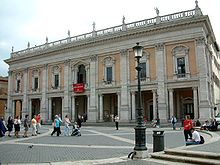Conservator's Palace
The Conservator's Palace ( Italian Palazzo dei Conservatori ) is a Renaissance building on the Capitol Square ( Piazza del Campidoglio ), west of the Roman Forum in Rome . Today a large part of the Capitoline Museums is housed there. A sculpture museum has existed there since the 16th century.
The conservators were between the 13th century and in 1870, the end of papal rule over the city, the "secular" city government of Rome, now with an elected magistrate comparable. They were in constant conflict with the papacy for supremacy in the city. At the time of the Roman Empire the triumphal procession ended at the Capitol Square , the square was entered from the forum.
In the Middle Ages, the Conservator's Palace was the seat of justice . On March 25, 1957, Belgium, the Federal Republic of Germany, France, Italy, Luxembourg and the Netherlands signed the Treaty of Rome establishing the European Economic Community and the European Atomic Energy Community in the Hall of Horatians and Curiatians .
Building history
Around 1537, Michelangelo Buonarroti was commissioned to redesign the Capitol Square . The tabulatorium (Senator's Palace) and the Conservator's Palace were located on Kapitolsplatz, both at an angle of 80 degrees to each other. The palace already had the continuous arcade , the round arches of which dominated the facade. The square to the west was framed by the church of Santa Maria in Aracoeli , which also towered over everything on a hill.
As a first measure, Michelangelo designed the pedestal for the equestrian statue of Mark Aurel in 1538 and planned the redesign of the building and the square based on this specification (from the Pope). A staircase, the Cordonata , leads up the Capitol Hill to the Capitol Square, at the front of which is the Senator's Palace. Michelangelo placed a mirror-like building opposite the Palazzo Nuovo to the Conservator's Palace , without having any idea for a use. The new building created a trapezoid, which Michelangelo made difficult to perceive with great sophistication. So he added lateral, symmetrical risalits to the Senator's Palace, which rotate about 4 degrees to the side palaces. The new yokes on the front sides of the Conservator's Palace are significantly narrower than those facing the square. If the yoke width of the front side were to apply to the square yokes, 9 instead of 7 yokes would characterize the facade. Anyone entering the square from the Cordonata can hardly see the inclination of the buildings.
The Conservator's Palace is structured in a colossal order, in which the two floors are combined by huge Corinthian pilasters . The portico , whose narrow side yokes were doubled under Pope Alexander VII , is supported by Ionic columns that do not carry an arch, but an entablature. Michelangelo planned continuous aedicule windows with a segmented gable and a small balcony in front. The large central window with the triangular gable was added later by Giacomo della Porta , who thereby shifted the emphasis on the vertical aspect in favor of centering the central axis.
Drawings by Maarten van Heemskerck from around 1555 prove that the double staircase at the Senator's Palace was completed during Michelangelo's lifetime, and the fountain was added later. The first arcade yokes of the Conservator's Palace had already been rebuilt or under construction. The cordonata was also ready. The work on the palace ended Michelangelo's successor Giacomo della Porta. In 1876 an extension took place.
The Palazzo Nuovo was built in the 17th century. The paving of the square took place in the 20th century during the Mussolini dictatorship.
Web links
Individual evidence
- ^ Palazzo dei Conservatori Museum: Palazzo dei Conservatori Museum. Retrieved May 5, 2020 (English): "The Palazzo dei Conservatori, headquarters of the magistrature of the same name for hundreds of years, has, since the end of the 15th century, been home to the Capitoline collection of sculptures."
- ↑ Thomas Grundmann: Architekturführer Rom , p. 143 ff, Stuttgart, London 1997, ISBN 3-930698-59-5
- ↑ http://www.museicapitolini.org/en/percorsi/percorsi_per_sale/museo_del_palazzo_dei_conservatori
- ↑ Allesandro Nova: Michelangelo: Der Architekt , Stuttgart, Zurich 1988, ISBN 3-7630-1796-8 , p. 115
Coordinates: 41 ° 53 ′ 34.8 " N , 12 ° 28 ′ 58.1" E

